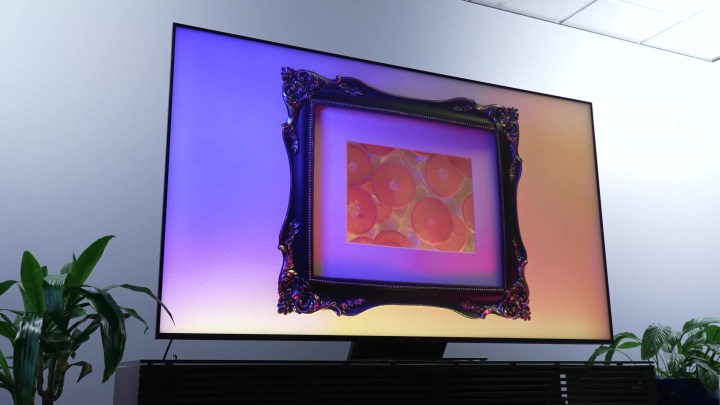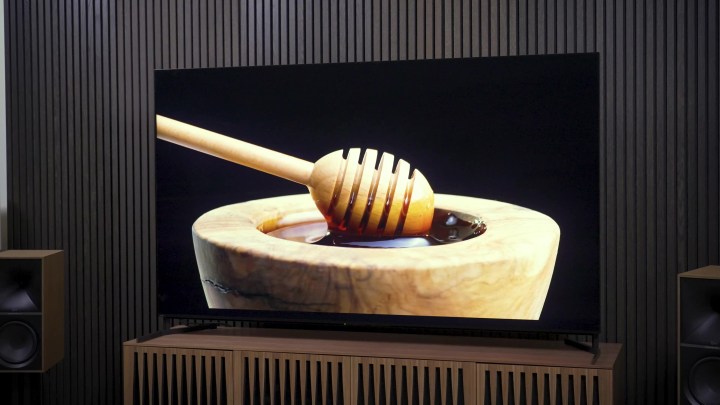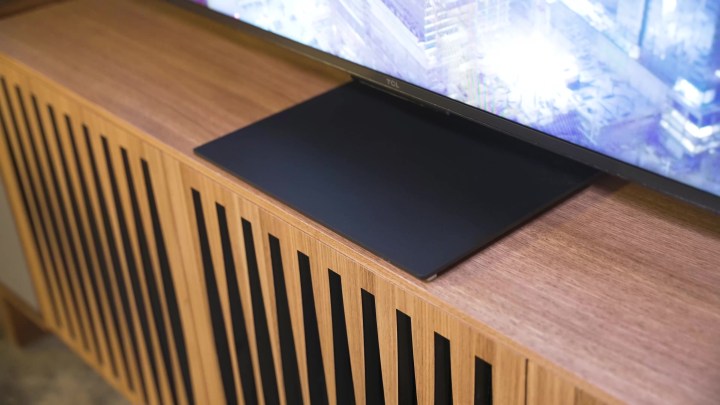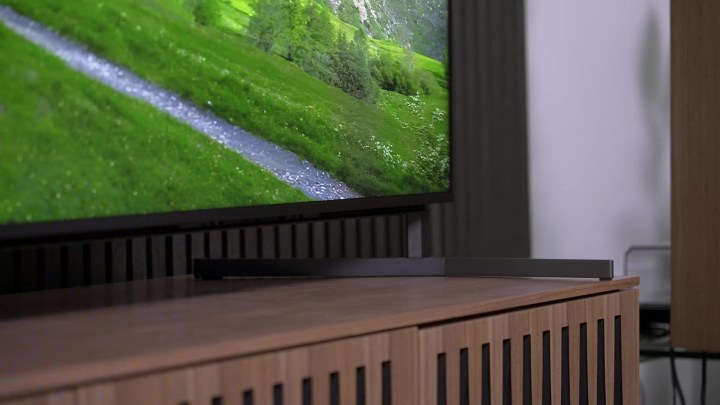This comparison puts Sony’s flagship mini-LED TV, the Sony X95L, versus the TCL QM8, TCL’s best mini-LED TV. I’ve called the Sony X95L the best LCD TV I’ve ever tested, and I’ve said that the TCL QM8 might just be the best value in TV right now, despite a few notable quirks.
But is this really a fair fight? There’s more than $2,000 separating these 85-inch TVs. In terms of price, Sony’s X90L is a closer match to the TCL QM8. But in terms of technology and the fact that these are the best LCD TVs on offer from Sony and TCL, I think this versus will be fun — never mind whether it makes a lot of sense.
I also think a lot of folks want to know how close the TCL, with its aggressive mini-LED backlight and dimming zone count, can get to the Sony (and if it can maybe even surpass it).
Sony X95L
TCL QM8
Design
These TVs have some notable design differences worth keeping in mind. The TCL QM8 uses a centralized pedestal stand that will allow it to sit on just about any size table. The Sony X95L, however, is going to need a larger stand. You can position the feet more toward the center of the TV for a narrower media cabinet, but as I’ve got it set up in our studio, the X95L is taking up all but five inches of our BDI console’s 79-inch width.
- 1. TCL QM8
- 2. Sony X95L
- 3. TCL QM8
- 4. Sony X95L
Otherwise, the TVs are sufficiently sleek and shallow, with trim bezels and virtually no difference in mounting depth, As far as aesthetics go, it’s a draw.
When it comes to the remotes, I like the slightly more compact size of the Sony. And when it comes to button layout, the Sony comes with some advantages, like a wrench button that brings up a pop-up menu for quick access to the most popular settings. But the TCL remote is backlit, and that’s going to get you the win every single time. The remote category goes to TCL.
Sound
I know we’re used to TVs just not sounding good, but both TCL and Sony have put in some effort here. And I know a lot of people figure that if you spend this much money on a TV, it needs to sound at least decent.
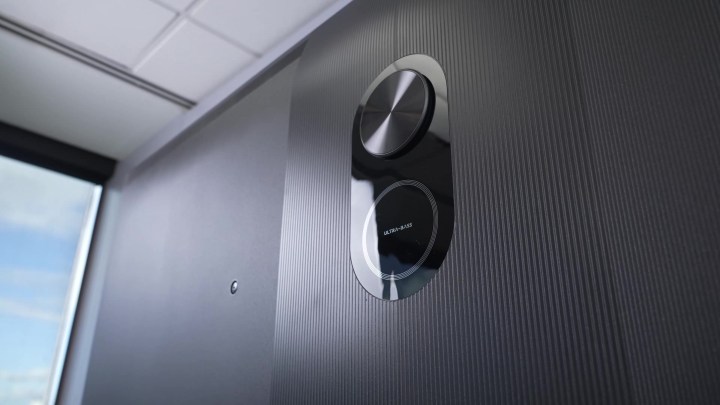
Well, I’m not in love with how either of these sets sound. I saw a review somewhere where the reviewer said the X95L lacks bass, and that is straight-up false. If you run the acoustic calibration system for the Sony X95L, you will absolutely get some bass out of this TV. More bass, as a matter of fact, than the TCL QM8, which has a dedicated subwoofer on the back. With the Sony, you also have some special integration with some of Sony’s soundbars, or systems like the HT-A9, where the TV can act as a center channel.
So, again, I’m not excited about the audio from either — I definitely will encourage you to consider at least a soundbar. But there’s a clear winner in the audio category, and it’s the Sony.
Google TV: UI and native apps
Now I want to talk about the Google TV integration. And before you go skipping this section because you think you don’t care — Google TV is Google TV, right? Wrong. Not all Google TV implementations end up being the same.
I won’t take up your time talking about how the menus are slightly different, or that Sony makes it easier to turn off Eco mode, or how they each have different versions of gaming dashboards. No, what I want to talk about is an issue that perhaps has always existed at some level, but it’s really starting to rear its ugly head now.
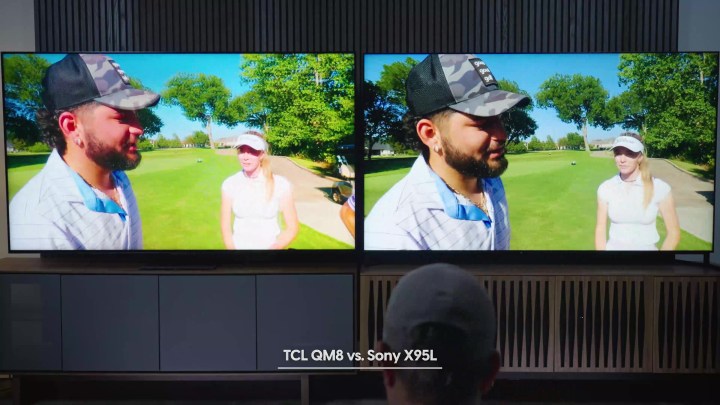
When I reviewed the TCL QM8, I watched a lot of the Good Good Golf YouTube channel and was beginning to think that hosts Colin and Ryder needed some color-grading workshops, because the skin tones on those videos were not great. Everyone looked sunburned. And while I know all those folks are getting plenty of sun out on the links, I know they aren’t supposed to look that red.
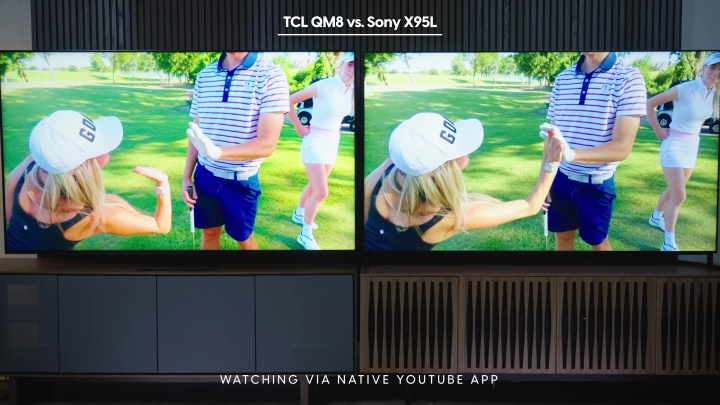
As it turns out, there’s nothing wrong with Colin and Ryder’s color-grading skills. The issue is the YouTube app built into this TV. And I’ve seen it on the 65-inch and the 98-inch models as well. Once the stream hits 4K resolution, here comes the red. Grace looked straight-up lobster-like on the TCL, but more pinkish on the Sony when we used each TV’s built-in YouTube app. But when we switch to the Apple TV as a source and play the same content, everything looks better. On both TVs, actually — but the horrible redness on everything that we saw on the TCL when it was using its built-in app is now gone.
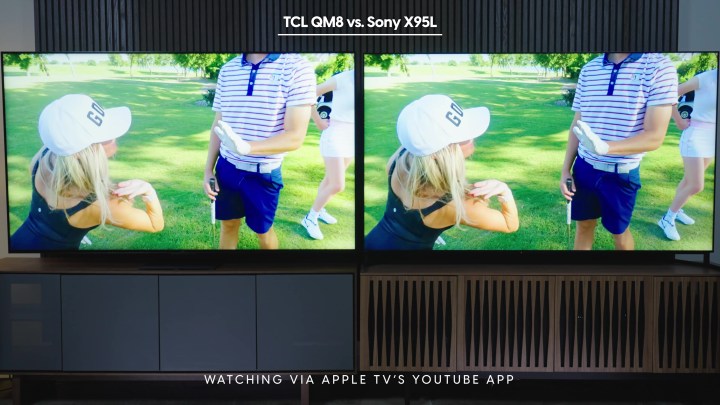
Lest you think this is a TCL problem, I found issues elsewhere. on the Max app built into the Sony X95, the left and right pillarbox bars on Justice League (in Dolby Vision, by the way) are gray instead of black. I actually thought this was an issue with the TV. But, again, I switched to the Apple TV 4K and used its Max app, pumped through to the TV via HDMI, and the pillarbox bars were as black as they should be.
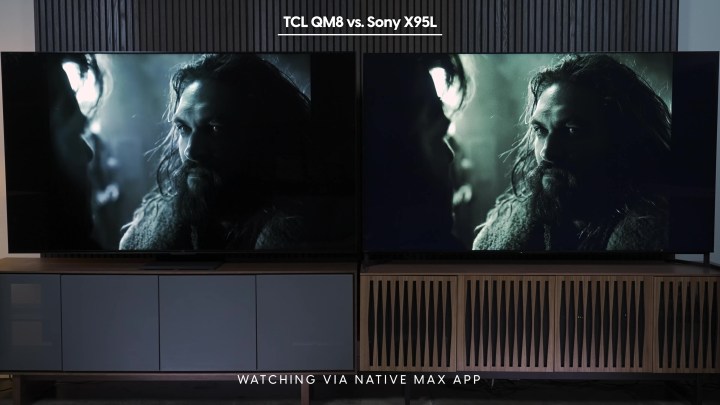
The takeaway is that I am losing my trust in the apps built into TVs. Not all are bad. It’s not always problematic. But sometimes it is. And do you want to wonder if you’re getting the best picture? I don’t. For that reason, I’m seriously thinking about not using built-in apps anymore. Not until all this gets ironed out, and I’m not sure it ever will.
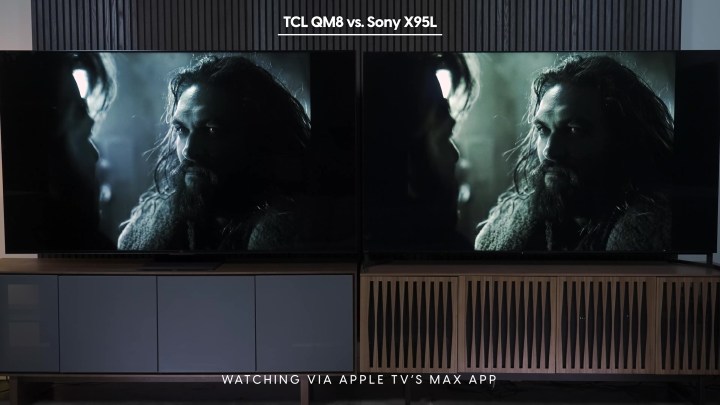
For now, when it comes to Google TV implementation, it’s a draw. But in this case, the draw really is a loss for both sets. I will say, though, that I prefer the Sony TV’s interface. TCL does have its own live-streaming TV service built in that you can use instead of Pluto or FreeVee (which Google TV itself has integrated). But at the end of the day, I like clicking around the Sony better, even though I wish the remote I used to do the clicking was TCL’s. Reluctantly, Sony gets the win for the interface.
Anti-glare and off-angle viewing
Sony has a slight edge when it comes to anti-glare. While both TVs reflected our studio light on a pitch-black screen when the light was right behind the camera, the Sony toned down the brightness of the reflection a little more. Once the TVs were on, the anti-glare on both was sufficient. I do have to remind everyone, though, that the sun beaming through a window behind you is always going to show up on your screen. There is no screen treatment technology that can fully eclipse the power of the sun (not yet, anyway). I know there are some crazy light-absorbing materials out there — you’ll see them in the best projector screens — but they aren’t in TVs yet. So just know that both have decent anti-glare, but the Sony X95L’s is just a touch better.
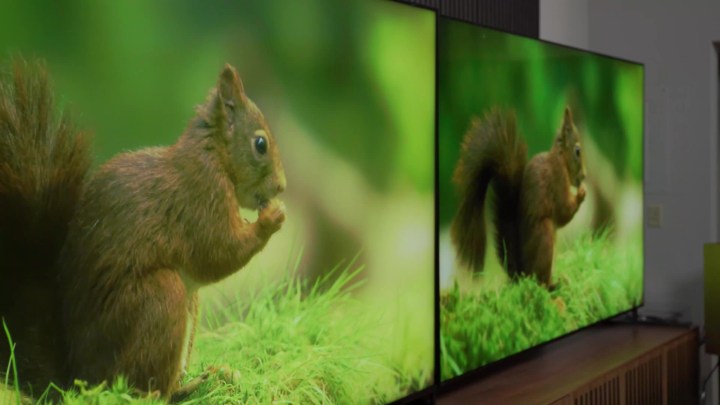
Next is off-angle viewing, and I am not going to waste your time because the contest is not even close. The Sony has outstanding off-angle performance, and the TCL QM8’s off-angle performance is not good at all. Once you are off dead center of the TCL QM8, its brightness advantages disappear. The Sony looks brighter from every angle other than straight on. Off-angle viewing? Sony’s got this one.
Picture quality
Now to the part I think you’ve all been waiting for: the picture quality comparison. You may have already guessed that Sony is going to win this section. But it’s worth reading to the end because there’s a bit of a twist that you might not see coming.
Brightness
Let’s start with brightness. There is no doubt that the TCL QM8 is a significantly brighter TV overall. By “overall,” I mean that the TCL QM8’s average picture level, or APL, is significantly higher than the Sony X95L’s APL. We compared three series of clips to get a full sense of each TV’s capabilities.
The first run of footage we examined was exposed for the TCL QM8. As such, it looked more or less normal, while the Sony X95L looked dim by comparison. It is extremely important that you understand that what we can show you here is not a real-life representation of what you see in person. Because of our cameras and workflow, plus the variable of what you’re reading this on, we can’t show you all the stops of brightness that we can see in real life. So the Sony X95L looked abnormally dim in this instance. But hopefully, you can still get a sense of the fact that the TCL QM8, on average, is significantly brighter.
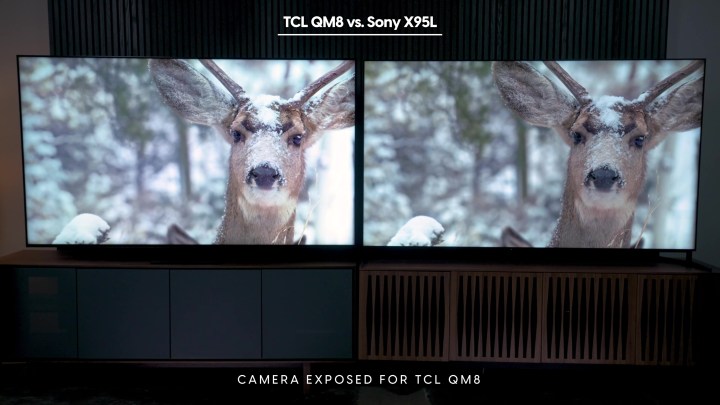
Now we’re going to show you the opposite. This is all HDR content, by the way, with the backlight systems maxed out. Below, you can see that by comparison, the TCL looks aggressively bright while the Sony is clearly putting out an excellent picture.

This third image is after I have backed the TCL’s brightness down from 100 — which is the default setting in HDR movie mode — to about 65, which perceptually matches the Sony X95L. And what I’m hoping you’ll see here is that the TCL still looks brighter overall. But what I really don’t want you to miss from this brightness discussion is the following:

While the TCL QM8 has a higher average picture level, the Sony’s HDR highlights are just as bright as the TCL QM8’s. And, because the Sony doesn’t overly brighten everything, its contrast therefore is better.
So, even though the TCL QM8 is brighter, I like what Sony is doing with its brightness power a little better. So the brightness category goes to Sony.
Color
We see Sony’s more refined approach having a positive net impact on color as well. The TCL QM8 has brighter colors, but they are ever so slightly washed-out compared to the Sony, which produces bright colors with depth and richness that the QM8 just can’t quite match.
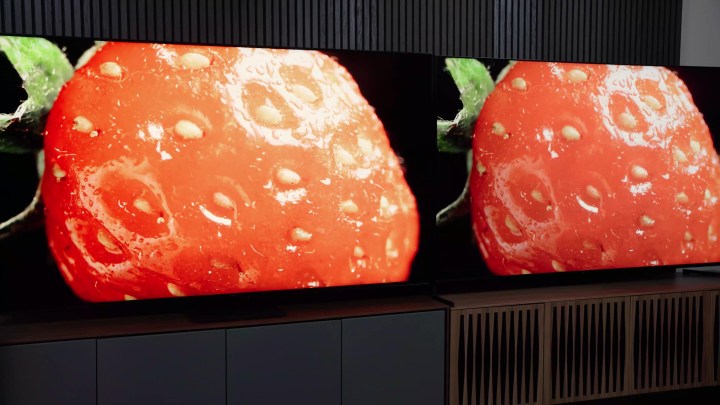
And, as I mentioned in the reviews for each of these TVs individually, Sony’s out-of-the-box color performance and white balance in the Custom picture preset is extremely accurate, whereas the TCL QM8’s is not as accurate and is harder to adjust toward accuracy using the TV’s content management system (CMS) and white-balance adjustments. In fact, I’ve heard from some folks that they just didn’t work for them at all. That’s not as damning as a statement as it may sound, though. Stick with me.
So, for color performance, Sony gets the win.
Black levels
In terms of black-level performance, as well as backlight performance, the TCL QM8 produces what appears to be slightly less halo around bright objects on pitch-black backgrounds than the Sony X95L. And I do mean slight. Also, you have to be dead on-angle for that to be seen on the TCL QM8. However, without having these TVs stacked side by side, I don’t know that you would be able to draw that conclusion because the Sony X95L is so good at hiding its dimming zones, and the contrast is so good on the TV that you aren’t going to pick up on the tiny bit of halo effect that is present. Also, the Sony has better shadow detail than the TCL QM8, which seems to achieve its inky blacks at the slight expense of a little shadow detail. I’m not sure how much folks would miss those shadow details unless they were looking specifically for them.
But if I have to pick a winner in the black level and backlight control category, I have to give it to the Sony X95L.
Motion
This is another win for the Sony, because Sony’s motion processing is just so dang good, but I want to point out that the TCL QM8 is no slouch. I see a bit more judder and stutter on the TCL QM8, but that’s only because I have to not use motion smoothing at all for my tastes, whereas with the Sony, I can turn Cinemotion on low and avoid soap opera effect while getting slightly smoother cinematic motion. So, for motion, it’s a win for Sony, but not by a landslide.
Upscaling and image processing
I’m putting these two in the same category for the convenience of talking about them concisely, but please remember that upscaling is the process of taking a lower-resolution image, for which there is only information for a fraction of the pixels on the screen, and upscaling that image so that it fills the whole screen. Without upscaling, a 1080p HD image would take up just one-quarter of one of these screens because a 4K TV has about four times the number of pixels. You have to go from 2 million or so in 1080p display and ramp that up to 8.3 million.
You can tell the difference in upscaling between two TVs when looking for the sharpness of the image. The Sony has a sharper, more detailed picture in general, so when upscaling 1080p and 720P sources, it’s still going to look a bit sharper.
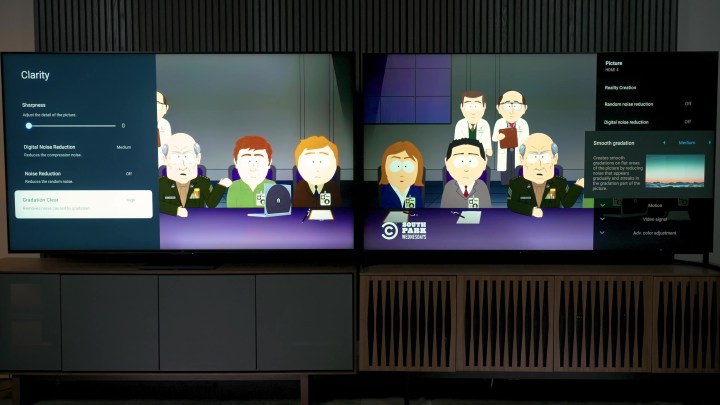
For cleanup of low-bit-depth content — like a lot of the content we stream on YouTube, for example — the difference is not very stark. The above image comes from content streaming in 720p on Sling TV. At first, there was plenty of color banding on both TVs, but as soon as I implemented smooth gradation features on each TV, they both cleaned up nicely. In fact, the QM8 does a slightly better job. Of course, when the picture is moving, the Sony is a little faster on cleanup, so when we stack it all together, the Sony looks slightly better, but the TCL is doing a remarkably decent job, and I’m not upset about it at all. I could easily live with the QM8.
Gaming
I’m going to touch on gaming very briefly because these TVs are very close in terms of their gaming features and performance. Both TVs have a lot to brag about. The Sony is touted as being the best mate for the PlayStation 5, because, of course it is. The TCL offers THX-certified game mode and FreeSync Premium Pro. It can also go up to 144Hz if you hardcore PC gamers out there need that. So far as I can tell, both of these TVs are superb for gaming. The HDR gaming performance is outstanding — of course, the Sony’s color is a bit more accurate still — but both have super-low input lag. Maybe not on the LG G3’s level, but very low. And the backlights don’t seem to freak out in VRR modes. It’s all very good.

I’m going to hand the TCL the gaming win for one reason and one reason only: its high-refresh-rate ports are separate from the eARC port. That’s it. If you have more than one gaming device that goes above 4K 60Hz, the TCL allows you to connect both and still have your eARC port available for a soundbar or AV receiver.
Value
So, if you’ve been keeping score, we can all see that Sony ran away with most of the category wins here. But there’s one category we have not discussed yet, and that is value.
Let me break it down for you like this: I prefer the Sony X95L. I would be thrilled to own this TV. I am sad that following this review, I have to pack it up so it can be returned. It will be missed. If cost were no object, I’d choose the Sony X95L in a heartbeat. It is, by most of the measures we have covered here, a superior TV in terms of accuracy, and it just happens to put out the picture quality that I like best.
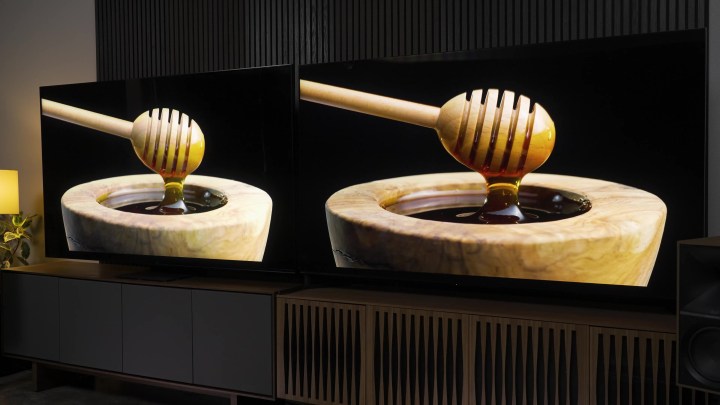
But here’s the thing. Cost is an object for most folks — and that even (or especially!) includes me. If I needed to buy an 85-inch TV using my money or the money of one of my close family members or friends, do you think I’m going to buy the X95L? No. Because that price is just way higher than what most folks are prepared to pay. I’m not saying that Sony has no business charging that much — it’s the best LCD TV on the market, so mark that puppy up, Sony! Be proud of what you’ve made. It’s an elite TV. Sell it for an elite price, and let those who can own it have the bragging rights.
No, even though I wish the TCL QM8 did a few things differently or better, I’m buying the QM8 all day. Yes, I’ll know in the back of my head that it is technically overly bright. I will know that the colors could technically be a bit richer than they are. And I’ll especially know that I’m not getting the best picture if I don’t have one of the two or three best seats in the house. But when you strip the QM8 out of this admittedly unfair comparison, it looks pretty terrific to most people.
So while the Sony X95L wins out technically, the winner of this shootout for the vast majority of consumers trying to purchase an 85-inch TV is the TCL QM8.
Sony X95L
TCL QM8
